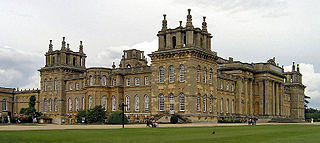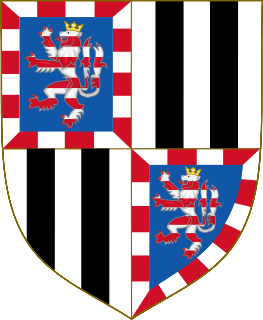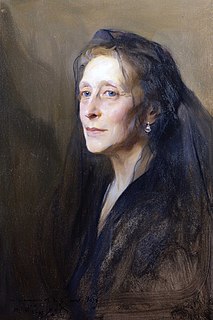History
Though mention of buildings on the site goes back to 1604, it was not developed as a country house until the master mason Edward Strong built his home here in the 18th century. Strong's career included work on St Paul's Cathedral and Blenheim Palace.
Edward William Strong was the Chancellor of the University of California at Berkeley between 1961 and 1965. He resigned in March 1965, in large part due to his actions during the Free Speech Movement, which was beginning at that time. Besides his role as chancellor, Strong founded UC Berkeley's Department of Sociology and Social Institutions in 1946, chaired it until 1953, as well as in another of other campus roles.

St Paul's Cathedral, London, is an Anglican cathedral, the seat of the Bishop of London and the mother church of the Diocese of London. It sits on Ludgate Hill at the highest point of the City of London and is a Grade I listed building. Its dedication to Paul the Apostle dates back to the original church on this site, founded in AD 604. The present cathedral, dating from the late 17th century, was designed in the English Baroque style by Sir Christopher Wren. Its construction, completed in Wren's lifetime, was part of a major rebuilding programme in the City after the Great Fire of London. The cathedral building largely destroyed in the Great Fire, now often referred to as Old St Paul's Cathedral, was a central focus for medieval and early modern London, including Paul's walk and St. Paul's Churchyard being the site of St. Paul's Cross.

Blenheim Palace is a monumental country house in Woodstock, Oxfordshire, England. It is the principal residence of the Dukes of Marlborough, and the only non-royal, non-episcopal country house in England to hold the title of palace. The palace, one of England's largest houses, was built between 1705 and 1722, and designated a UNESCO World Heritage Site in 1987.
During the mid-19th century Sopwell House known then as New Barnes (or New Barns) was the seat of the philanthropist Mrs. Isabella Worley. Amongst the many donations to St Albans from this benefactor were Christ Church on Verulam Road and the Wooden Room in Lattimore Road.
The house was extended in Victorian times and in 1900 was leased to Prince Louis of Battenberg, an Admiral of the Royal Navy who made it his family home. His 4 children grew up here, Alice Mountbatten, Louise Mountbatten, George Mountbatten and Louis Mountbatten. They all had notable lives.

Admiral of the Fleet Louis Alexander Mountbatten, 1st Marquess of Milford Haven,, formerly Prince Louis Alexander of Battenberg, was a British naval officer and German nobleman related to the British royal family.
Admiral is one of the highest ranks in some navies, and in many navies is the highest rank. It is usually abbreviated to "Adm" or "ADM". The rank is generally thought to have originated in Sicily from a conflation of Arabic: أمير البحر, amīr al-baḥr, "commander of the sea", with Latin admirabilis ("admirable") or admiratus ("admired"), although alternative etymologies derive the word directly from Latin, or from the Turkish military and naval rank miralay. The French version – amiral without the additional d – tends to add evidence for the Arab origin.

The Royal Navy (RN) is the United Kingdom's naval warfare force. Although warships were used by the English kings from the early medieval period, the first major maritime engagements were fought in the Hundred Years' War against the Kingdom of France. The modern Royal Navy traces its origins to the early 16th century; the oldest of the UK's armed services, it is known as the Senior Service.
The young Louis, like his father, had a distinguished Royal Navy career and was to become the last British Viceroy of India as Louis Mountbatten, 1st Earl Mountbatten of Burma. Alice married Prince Andrew of Greece and their son is Prince Philip, Duke of Edinburgh. The proposal of marriage was made in the grounds of the house. Louise Mountbatten went on to marry and become Queen of Sweden.

Louis Francis Albert Victor Nicholas Mountbatten, 1st Earl Mountbatten of Burma, was a British Royal Navy officer and statesman, an uncle of Prince Philip, Duke of Edinburgh, and second cousin once removed of Queen Elizabeth II. During the Second World War, he was Supreme Allied Commander, South East Asia Command (1943–1946). He was the last Viceroy of India (1947) and the first Governor-General of independent India (1947–1948).

Prince Philip, Duke of Edinburgh, is the husband of Queen Elizabeth II of the United Kingdom and the other Commonwealth realms.
The home passed to the Verulam family after the Second World War and was sold to become a hotel in 1969.

Earl of Verulam is a title in the Peerage of the United Kingdom. It was created in 1815 for James Grimston, 4th Viscount Grimston. He was made Viscount Grimston at the same time. Verulam had previously represented St Albans in the House of Commons. In 1808 he had also succeeded his maternal cousin as tenth Lord Forrester. He was succeeded by his son, the second Earl. He was a Tory politician and held minor office in the first two governments of the Earl of Derby. His son, the third Earl, represented St Albans in Parliament as a Conservative. His grandson, the sixth Earl was nominated to the traditionally safe seat of St Albans for the party. As of 2017 the titles are held by his son, the seventh Earl, who succeeded in 1973.

World War II, also known as the Second World War, was a global war that lasted from 1939 to 1945. The vast majority of the world's countries—including all the great powers—eventually formed two opposing military alliances: the Allies and the Axis. A state of total war emerged, directly involving more than 100 million people from over 30 countries. The major participants threw their entire economic, industrial, and scientific capabilities behind the war effort, blurring the distinction between civilian and military resources. World War II was the deadliest conflict in human history, marked by 70 to 85 million fatalities, most of whom were civilians in the Soviet Union and China. It included massacres, the genocide of the Holocaust, strategic bombing, premeditated death from starvation and disease, and the only use of nuclear weapons in war.

Mountbatten-Windsor is the personal surname used by some of the male-line descendants of Queen Elizabeth II and Prince Philip, Duke of Edinburgh. Under a declaration made in Privy Council in 1960, the name Mountbatten-Windsor applies to male-line descendants of the Queen without royal styles and titles. Individuals with royal styles do not usually use a surname, but some descendants of the Queen with royal styles have used Mountbatten-Windsor when a surname was required.

Romsey is a historic market town in the county of Hampshire, England. Romsey was home to the 17th-century philosopher and economist William Petty and the 19th-century British prime minister, Lord Palmerston, whose statue has stood in the town centre since 1857. The town was also home to the 20th-century naval officer and statesman Louis Mountbatten, 1st Earl Mountbatten of Burma, who lived at Broadlands. Notable buildings include a 13th-century hunting lodge, an 18th-century coaching inn and the 19th-century Corn Exchange.

Philip Alexius de László, MVO was an Anglo-Hungarian painter known particularly for his portraits of royal and aristocratic personages. In 1900, he married Lucy Guinness of Stillorgan, County Dublin, and became a British subject in 1914.

The Mountbatten family is a European dynasty originating as a cadet branch of the German princely Battenberg family. The name was adopted during World War I by family members residing in the United Kingdom due to rising anti-German sentiment amongst the British public. The name is a direct Anglicisation of the German Battenberg, a small town in Hesse. The title of count of Battenberg, later prince of Battenberg, was granted to a morganatic branch of the House of Hesse-Darmstadt, itself a cadet branch of the House of Hesse, in the mid 19th century.

The Battenberg family was formally a morganatic branch of the House of Hesse-Darmstadt, rulers of the Grand Duchy of Hesse in Germany. The first member was Julia Hauke, whose brother-in-law Grand Duke Louis III of Hesse created her Countess of Battenberg with the style Illustrious Highness in 1851, at her morganatic marriage to Grand Duke Louis' brother Prince Alexander of Hesse and by Rhine, and elevated her title to Princess of Battenberg with the style Serene Highness (HSH) in 1858. The name Battenberg was last used by her youngest son, Prince Francis Joseph of Battenberg, who died childless in 1924. Most members of the family, residing in the United Kingdom, had renounced their German titles in 1917, due to rising anti-German sentiment among the British public during World War I, and changed their name to Mountbatten, an anglicised version of Battenberg. The name Battenberg refers to the town of Battenberg in Hesse.

Broadlands is an English country house, located in the civil parish of Romsey Extra, near the town of Romsey in the Test Valley district of Hampshire, England. The formal gardens and historic landscape of Broadlands are Grade II* listed on the Register of Historic Parks and Gardens. The house itself is Grade I listed.

Princess Victoria of Hesse and by Rhine, later Victoria Mountbatten, Marchioness of Milford Haven was the eldest daughter of Louis IV, Grand Duke of Hesse and by Rhine (1837–1892), and his first wife Princess Alice of the United Kingdom (1843–1878), daughter of Queen Victoria and Prince Albert of Saxe-Coburg and Gotha.
Norton Louis Philip Knatchbull, 3rd Earl Mountbatten of Burma, known until 2005 as Lord Romsey and until 2017 as The Lord Brabourne, is a British peer.

St Albans is a constituency represented in the House of Commons of the UK Parliament since 2005 by Anne Main, a Conservative.

Captain George Louis Victor Henry Serge Mountbatten, 2nd Marquess of Milford Haven,, born Prince George of Battenberg, styled Earl of Medina between 1917 and 1921, was a Royal Navy officer and the elder son of Louis Mountbatten, 1st Marquess of Milford Haven and Princess Victoria of Hesse and by Rhine. His subsidiary titles included Viscount Alderney.

Louise Alexandra Marie Irene Mountbatten, previously Princess Louise of Battenberg, was Queen of Sweden from the accession of her husband, Gustaf VI Adolf, in 1950 until her death.

Old Gorhambury House located near St Albans, Hertfordshire, England, is a ruined Elizabethan mansion, a leading and early example of the Elizabethan prodigy house. It was built in 1563–68 by Sir Nicholas Bacon, Lord Keeper, and was visited a number of times by Queen Elizabeth. It is a Grade I listed building.

St Albans High School for Girls is a selective, independent day school for girls aged 4 – 18 years, which is affiliated to the Church of England and takes girls of all faiths or none. There are approximately 310 pupils in the Preparatory School with 480 in the Senior School and 160 Sixth Formers.

Verulam House is located in Verulam Road, St Albans on the northwestern side between Church Crescent and Britton Avenue opposite College Street. It has previously been referred to as Diocesan House and also known as the Bishop's Palace. It is of early nineteenth-century origin and is a Grade II Listed Building.

Gorhambury House is a Palladian-style house near St Albans; Hertfordshire, England. It was built in the years 1777–84 to replace Old Gorhambury House, which was left to fall into ruin.

The Hare and Hounds is a public house at 104 Sopwell Lane in St Albans, Hertfordshire, England. The timber framed building has a plastered exterior. It is listed Grade II with Historic England and is dated "seventeenth century or earlier".


























